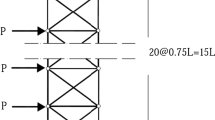Abstract
It is shown that an algebraic interval solution of interval linear algebraic systems with matrix composed of “reverse” interval elements of the input matrix is a maximum inner estimation for the mited solution set in the sense of inclusion.
Abstract
Показано, пто алиебранчецкое ннтериалъное решенне интервальной линейной алгебраической системы матрина которой которои составлена из “инвептиронаиных” интервалов —алементов исхолной матрины является макснмалчной оненкой снизы лля обьелиненноо множестиа решений в цмысле нклочеиия.
Similar content being viewed by others
References
Gardenes, E. andTrepat, A. Fundamentals of SIGLA, an interval computing system over the completed set of interoals. Computing24 (1980). pp. 161–179.
Baucher, C. W. Interval analysis in the extended interval space Iℝ Computing Supplementum2 (1980), pp. 33–49.
Khlebalin, N. A. An analytical method for the synthesis of regulators under conditions of uncertainty in the plant’s parameters. In: “Analytical Methods for the Synthesis of Regulators Coll. of Scien. Proc.” Saratov Polytechnic Institute, Saratov, 1981. pp. 107–123 (in Russian).
Shary, S. P.,On some methods for solving the linear tolerance problem. Preprint 6, Computer Center, Siberian Branch of the USSR Academy of Sciences, Krasnoyarsk, 1989 (in Russian).
Shary, S. P. On compatibility of the linear tolerance problem. Interval Computation 1 (1991), pp. 92–98.
Shary, S. P. A new class of algorithms for optimal solution of interval linear systems. Interval Computations 4 (1992), pp. 18–29.
Shary, S. P. Algebraic approach to the interval linear static identification, tolerance and control problems, or One more application of Kaucher arithmetic. Reliable Computing (1995), to appear.
Zakharov, A. V. The solution of interval linear systems Ax=b and their properties. Dep. in VIMI 16.02.1989, N D007755 (in Russian).
Zakharov, A. V. Constructing an interval algebraic solution in extended interval arithmetic. In: “Proc. All-Union Conf. on Actual Problems of Applied Mathematics, Saratov, May 20–22, 1991”, Saratov, 1991, pp. 311–317 (in Russian).
Zakharov, A. V. andShokin, Yu. I. An algebraic interval solution for systems of algebraic equations Ax=b and Ax+d=b In: “Preprint 5, Computer Center, Siberian Branch of the USSR Academy of Sciences”, Krasnoyarsk, 1987, pp. 10–12 (in Russian).
Zyuzin, V. S. On a way of finding two-sided interval approximations for the solution of linear interval system of equations. In: “Diff. Equations and Functions Theory, Diff. Operatory i Voprosy Priblizheniya 7, Coll. of Sci. Proc.”, Saratov Univ., Saratov, 1987, pp. 28–32 (in Russian).
Zyuzin, V. S. An iterative method for solving a system of segment algebraic equations. In: “Diff. Equations and Functions Theory, Diff. Operatory i Voprosy Priblizheniya 8, Coll. of Sci. Proc.”, Saratov Univ., Saratov, 1989. pp. 72–82 (in Russian).
Author information
Authors and Affiliations
Rights and permissions
About this article
Cite this article
Kupriyanova, L., КуПиянова, А. Inner estimation of the united solution set of interval linear algebraic system. Reliable Comput 1, 15–31 (1995). https://doi.org/10.1007/BF02390519
Received:
Revised:
Issue Date:
DOI: https://doi.org/10.1007/BF02390519




